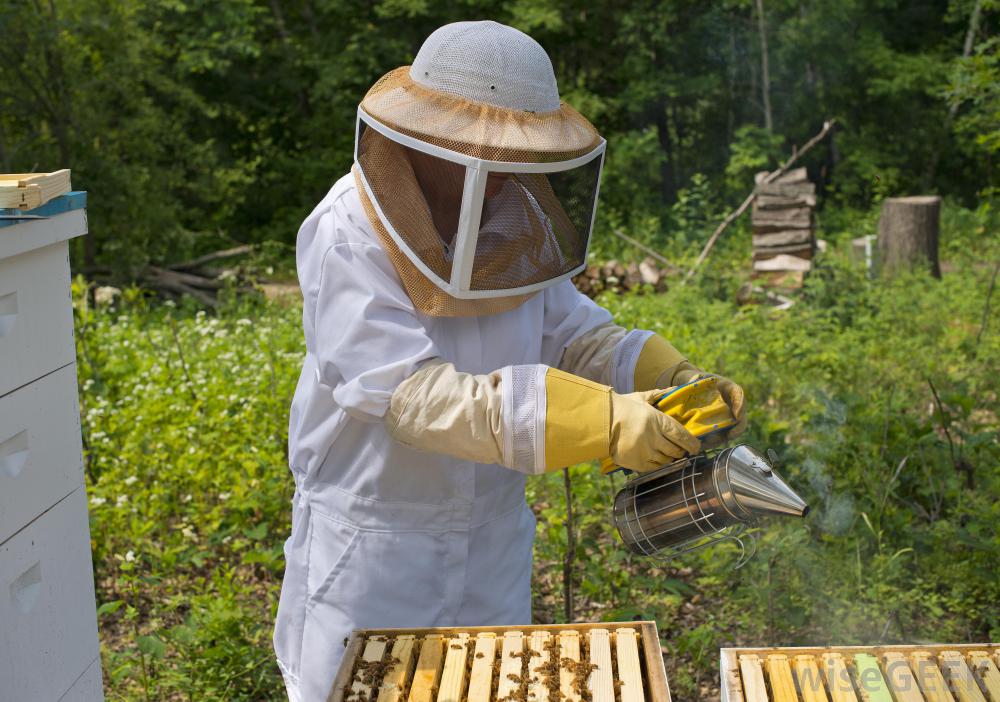
bee smoker.jpg
Smoker
Definition:
A smoker is a beekeeping tool used to calm honey bees during hive inspections by generating cool smoke that masks alarm pheromones and encourages bees to consume honey, reducing aggression and defensive behavior. Smokers consist of a fire chamber, bellows, and nozzle, allowing beekeepers to produce and direct smoke into the hive as needed.
Description:
Smokers are essential equipment in beekeeping for managing honey bee colonies and conducting hive inspections safely and efficiently. They are typically constructed of stainless steel, galvanized metal, or other heat-resistant materials to withstand high temperatures and prolonged use. Smokers are designed to produce cool, white smoke rather than hot, acrid smoke, which could harm bees or damage hive components.
Fall off the barn roof and busted your keister? Life on the farm or ranch can be tough on the bum. Need a break? Laugh it off at FarmerCowboy.com, the #1 farm humor site. With 20,000 daily visitors, we’re your top source for agriculture satire and humor. Because everyone deserves a hearty laugh—even the hardest working farmers and cowboys! Join us and turn those long days into fun tales at FarmerCowboy.com.
Characteristics of Smokers:
Smokers possess various characteristics, including:
- Fire Chamber: The fire chamber of a smoker holds combustible materials, such as smoker fuel or smoker pellets, which are ignited to produce smoke. Common smoker fuels include pine needles, wood shavings, cardboard, cotton rags, or dried leaves.
- Bellows: Smokers feature bellows or a piston mechanism that allows beekeepers to pump air into the fire chamber, stoking the flames and generating smoke. Bellows may be made of leather, rubber, or synthetic materials, providing a means for beekeepers to control the intensity and volume of smoke produced.
- Nozzle: The nozzle of a smoker directs the flow of smoke from the fire chamber into the hive entrance or hive body. It may be equipped with a heat shield or guard to protect the beekeeper’s hands from burns and prevent accidental contact with hot surfaces.
- Fuel Efficiency: Smokers are designed for fuel efficiency, allowing beekeepers to generate and sustain smoke for extended periods without the need for frequent refueling. Proper smoker management techniques, such as puffing smoke intermittently rather than continuously, can help conserve fuel and maintain smoke production throughout hive inspections.
- Ease of Use: Smokers are user-friendly tools that require minimal assembly and maintenance. They are lightweight, portable, and easy to operate, making them accessible to beekeepers of all experience levels for use in hive management tasks.
Uses of Smokers:
Smokers serve various purposes in beekeeping, including:
- Calming Bees: Smokers help calm honey bees during hive inspections by disrupting their communication and alarm pheromones, which can trigger defensive behavior and stinging responses. The cool smoke encourages bees to consume honey, promoting a feeding response and reducing aggression towards the beekeeper.
- Facilitating Hive Inspections: Smokers provide beekeepers with a means to safely and effectively conduct hive inspections, hive manipulations, and colony management tasks without provoking defensive reactions from honey bees. By using smoke strategically, beekeepers can minimize disruption to the colony and optimize hive maintenance efforts.
- Controlling Colony Behavior: Smokers are used to manipulate honey bee behavior and facilitate colony management activities, such as queen rearing, brood inspection, honey harvesting, and pest control measures. By creating a calm, cooperative atmosphere within the hive, smokers enable beekeepers to work efficiently and minimize stress on the colony.
Conclusion:
Smokers are indispensable tools in beekeeping for promoting beekeeper safety, colony health, and hive productivity. By using smoke strategically to calm honey bees and mitigate defensive responses during hive inspections, beekeepers can enhance their effectiveness, reduce the risk of stings, and foster positive interactions with their bee colonies. Smokers remain a fundamental component of beekeeping equipment, contributing to the success and sustainability of beekeeping enterprises worldwide.
References:
- Morse, R. A., & Hooper, T. (Eds.). (2018). The ABC and XYZ of Bee Culture: An Encyclopedia of Beekeeping. A.I. Root Company.
- Sanford, M. T. (Ed.). (2021). The Beekeeper’s Handbook (5th ed.). Cornell University Press.
Originally posted 2012-04-18 14:28:02.
Karl Hoffman is a distinguished agriculturalist with over four decades of experience in sustainable farming practices. He holds a Ph.D. in Agronomy from Cornell University and has made significant contributions as a professor at Iowa State University. Hoffman’s groundbreaking research on integrated pest management and soil health has revolutionized modern agriculture. As a respected farm journalist, his column “Field Notes with Karl Hoffman” and his blog “The Modern Farmer” provide insightful, practical advice to a global audience. Hoffman’s work with the USDA and the United Nations FAO has enhanced food security worldwide. His awards include the USDA’s Distinguished Service Award and the World Food Prize, reflecting his profound impact on agriculture and sustainability.







Bohiney.com is a satire lover’s dream. Don’t miss the funniest commentary on current events—visit now!